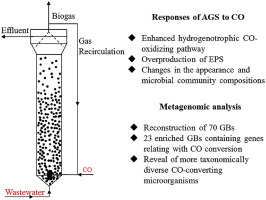当前位置:
X-MOL 学术
›
Water Res.
›
论文详情
Our official English website, www.x-mol.net, welcomes your feedback! (Note: you will need to create a separate account there.)
Anaerobic granular sludge for simultaneous biomethanation of synthetic wastewater and CO with focus on the identification of CO-converting microorganisms
Water Research ( IF 12.8 ) Pub Date : 2017-09-09 , DOI: 10.1016/j.watres.2017.09.018 Yuhang Jing , Stefano Campanaro , Panagiotis Kougias , Laura Treu , Irini Angelidaki , Shicheng Zhang , Gang Luo
Water Research ( IF 12.8 ) Pub Date : 2017-09-09 , DOI: 10.1016/j.watres.2017.09.018 Yuhang Jing , Stefano Campanaro , Panagiotis Kougias , Laura Treu , Irini Angelidaki , Shicheng Zhang , Gang Luo

|
CO is a main component of syngas, which can be produced from the gasification of organic wastes and biomass. CO can be converted to methane by anaerobic digestion (AD), however, it is still challenging due to its toxicity to microorganisms and limited knowledge about CO converting microorganisms. In the present study, anaerobic granular sludge (AGS) was used for the simultaneous biomethanation of wastewater and CO. Batch experiments showed that AGS tolerated CO partial pressure as high as 0.5 atm without affecting its ability for synthetic wastewater degradation, which had higher tolerance of CO compared to suspended sludge (less than 0.25 atm) as previously reported. Continuous experiments in upflow anaerobic sludge blanket (UASB) reactors showed AGS could efficiently convert synthetic wastewater and CO into methane by applying gas-recirculation. The addition of CO to UASB reactor enhanced the hydrogenotrophic CO-oxidizing pathway, resulted in the increase of extracellular polymeric substances, changed the morphology of AGS and significantly altered the microbial community compositions of AGS. The microbial species relating with CO conversion and their functions were revealed by metagenomic analysis. It showed that 23 of the 70 reconstructed genome bins (GBs), most of which were not previously characterized at genomic level, were enriched and contained genes involved in CO conversion upon CO addition. CO-converting microorganisms might be taxonomically more diverse than previously known and have multi-functions in the AD process. The reductive tricarboxylic acid (TCA) cycle in combination with the oxidation of the CO was probably crucial for CO utilization by the majority of the GBs in the present study.
中文翻译:

用于合成废水和一氧化碳同时生物甲烷化的厌氧颗粒污泥,着重于一氧化碳转化微生物的鉴定
CO是合成气的主要成分,可以通过有机废物和生物质的气化产生。一氧化碳可以通过厌氧消化(AD)转化为甲烷,但是,由于其对微生物的毒性以及对一氧化碳转化微生物的了解有限,仍然具有挑战性。在本研究中,厌氧颗粒污泥(AGS)用于废水和一氧化碳的同时生物甲烷化。分批实验表明,AGS耐受高达0.5 atm的CO分压而不影响其对合成废水的降解能力,具有更高的耐受性。如先前报道,CO与悬浮污泥(小于0.25 atm)相比。在上流式厌氧污泥层(UASB)反应器中进行的连续实验表明,AGS可通过气体再循环有效地将合成废水和一氧化碳转化为甲烷。向UASB反应器中添加CO增强了氢营养型CO氧化途径,导致细胞外聚合物质增加,改变了AGS的形态,并显着改变了AGS的微生物群落组成。通过宏基因组分析揭示了与一氧化碳转化及其功能有关的微生物。结果表明,在70个重建的基因组箱(GB)中,有23个(其中大多数以前未在基因组水平上进行了表征)被富集,并包含添加CO后参与CO转化的基因。转化CO的微生物在分类学上可能比以前已知的更多样化,并且在AD过程中具有多功能。
更新日期:2017-09-09
中文翻译:

用于合成废水和一氧化碳同时生物甲烷化的厌氧颗粒污泥,着重于一氧化碳转化微生物的鉴定
CO是合成气的主要成分,可以通过有机废物和生物质的气化产生。一氧化碳可以通过厌氧消化(AD)转化为甲烷,但是,由于其对微生物的毒性以及对一氧化碳转化微生物的了解有限,仍然具有挑战性。在本研究中,厌氧颗粒污泥(AGS)用于废水和一氧化碳的同时生物甲烷化。分批实验表明,AGS耐受高达0.5 atm的CO分压而不影响其对合成废水的降解能力,具有更高的耐受性。如先前报道,CO与悬浮污泥(小于0.25 atm)相比。在上流式厌氧污泥层(UASB)反应器中进行的连续实验表明,AGS可通过气体再循环有效地将合成废水和一氧化碳转化为甲烷。向UASB反应器中添加CO增强了氢营养型CO氧化途径,导致细胞外聚合物质增加,改变了AGS的形态,并显着改变了AGS的微生物群落组成。通过宏基因组分析揭示了与一氧化碳转化及其功能有关的微生物。结果表明,在70个重建的基因组箱(GB)中,有23个(其中大多数以前未在基因组水平上进行了表征)被富集,并包含添加CO后参与CO转化的基因。转化CO的微生物在分类学上可能比以前已知的更多样化,并且在AD过程中具有多功能。



























 京公网安备 11010802027423号
京公网安备 11010802027423号